-
News & Trends -
Sales -
Marketing Related Topics -
B2B Software Guides Related Topics -
Free Tools & Resources -
- About Us About Us


A sales funnel is the visual representation of your customer journey, from their POV, as they progress from brand awareness to contract renewal. Typically, a sales funnel consists of the following six stages: awareness, interest, evaluation, decision, sale, and renewals. Salespeople and marketers build, manage, and analyze funnels, often in a CRM, to understand what any individual lead is doing or thinking at the time, and to measure and improve funnel performance.
Marketers, sellers, and business owners divide their business’s typical customer journey into several distinct stages — awareness, interest, evaluation, etc., — and document them inside of their CRM, thus creating a virtual, tangible sales funnel. You can then track funnel metrics like conversion rates between stages, and pinpoint any lead’s current location within the journey.
Though funnels vary across businesses, most contain the following six stages:
A funnel is typically depicted as an upside-down triangle, widest at the top (awareness) and narrowest at the bottom (renewal). In other words, a company usually has more leads in the awareness stage than the interest stage, more in the evaluation stage than the decision stage, and so on. That’s because leads drop out of the funnel and only the best-fit leads make it to loyal customer status. Though dropout is inevitable, there are ways to reduce it.
Through sales funnel reporting in your CRM or sales funnel software, you can spot leaks in your funnel, be it a poorly written sales page or a lame email sequence, and patch them up. Further, a visual funnel gives you insight into what your leads, prospects, and customers are currently doing and thinking, so you can pick the right strategies to propel them forward to the next stage.
There are usually six sales funnel stages in a business’s sales funnel. But, two different businesses might call the same stage by two different names. For instance, one business might use “discovery” for “evaluation.” Below we’ll cover the six stages, what buyers typically think about your brand in each stage, and what activities salespeople and marketers use to move buyers through each stage.
The awareness stage begins when a lead becomes aware of your company’s brand and ends when they take an action that you consider indicative of their interest in your brand, whether that’s signing up for a newsletter or downloading an ebook. During the awareness stage, leads have scant information about your business and the problems you solve, so it’s your job to educate them using methods like blogging, social media marketing, and running online ads.
Now that you know the different stages, let’s go over how to create, digitize, and manage a sales funnel for your specific business.
For more on the stages, check out our article sales funnel stages, where we go in depth into the intricacies of each stage and their related marketing and sales strategies. We also provide an example of each stage from the eyes of a lead.
The steps for creating and managing a sales funnel include identifying your typical customer journey, breaking it into the six sales funnel stages, documenting it using sales funnel software (often a CRM), and managing the funnel and tracking its metrics in order to optimize the customer experience and increase conversion rates.
Take a step inside your average customer’s shoes and go through the experience of becoming a customer. Jot down the various pathways they might take from awareness to purchase. Document the touchpoints — the ads, cold emails, blog content, live demos, checkout pages, etc., — that they experience. Once you have a few common paths, maybe one for each buyer persona, write down the actions that almost every buyer takes. This is your archetypal journey.
For example, an online course creator might have the following journey:
If you’re starting fresh and don’t have any customers just yet, you get to start from scratch and imagine your ideal customer journey. What would be the best step-by-step method for convincing a stranger to become a customer, and what marketing content and sales tactics would that require? The next step should help you start thinking about the touchpoints at your disposal and how they work to move people through the stages of the sales funnel.
Now that you have a sequence of touchpoints, divide it into the six sales funnel stages. Each touchpoint’s stage will depend on how the average customer feels about your brand during that touchpoint. For example, touchpoints where leads are just learning about your brand, like social media posts, will fall under the awareness stage. Others, like visiting the pricing page, signify that the lead is researching your product, and should thus go in the evaluation stage.
Here’s an example of how a business might divide its touchpoints into six stages:
The benefits of dividing the journey into distinct stages will be most apparent when you build a virtual sales funnel using software. Because each funnel stage is associated with certain behavior and desires, dividing your customer journey into stages will allow you to quickly assess any specific buyer’s needs with a quick glance at the sales funnel dashboard. Via reporting, you can also monitor conversion rates between stages and identify chokepoints in your sales funnel.
Make sure to specify the action in each stage that leads must take to move into the next stage in the funnel. For example, the rule for getting into the evaluation stage might be that customers have to fill out a “contact us” form. To get into the decision state, they might have to request or receive a proposal. Defining the gateway actions that separate stages helps you ensure that each buyer is always in the appropriate stage, and as a result your funnel reporting is accurate.
Now that you’ve turned your customer journey into a written sales funnel with the appropriate stages and their corresponding touchpoints, it’s time to make it virtual, trackable, and open to analysis. Using a CRM or sales funnel point-solution, you can build a virtual funnel. You’ll be able to choose the stage names and set up automation rules that move leads through the stages when they take a specified action. Then you can track leads as they move through it.
After you’ve documented your sales funnel in a software platform, you’ll be able to track it and analyze it to uncover key metrics such as funnel conversion rate. Plus, you can use the tool’s sales and marketing features, like an email campaign builder or a landing page builder, to create and manage digital assets that propel buyers through the funnel toward a purchase.
Quick Note: Many B2B salespeople using a CRM may create a horizontal virtual sales pipeline and not use a virtual funnel. They’ll use stage names associated with the salesperson’s actions rather than the customer’s journey — e.g., “contract sent” instead of “decision.” If this is how you prefer to visualize your customer journey, that’s okay, but you should make sure the digital pipeline stages line up with your funnel stages, and you should run funnel reports regularly.
To learn more about sales funnel solutions and how they work, check out our article on the best sales funnel software, where we introduce you to some great tools and highlight their primary use-cases, core features, and pricing.
Sales funnel management is the ongoing process of monitoring, reporting on, and improving your funnel. It includes activities like monitoring key funnel metrics, identifying and patching funnel leaks, and optimizing your re-engagement process. Most of these activities you’ll do on a weekly or monthly basis, but others, like assessing your funnel software, can be done less frequently. Consistency and diligence in this regard lead to a well-functioning sales funnel.
To understand this recurring process in depth, check out our article on sales funnel management, where we cover the most critical sales funnel management activities and teach you how to do them.
Below is a HubSpot sales funnel example from the point of view of a small business owner who’s trying to improve their marketing strategy. By studying effective sales funnels like the one below, you can find techniques and content ideas to integrate into your own. Read on to see how HubSpot turns a curious internet browser into a long-term customer.
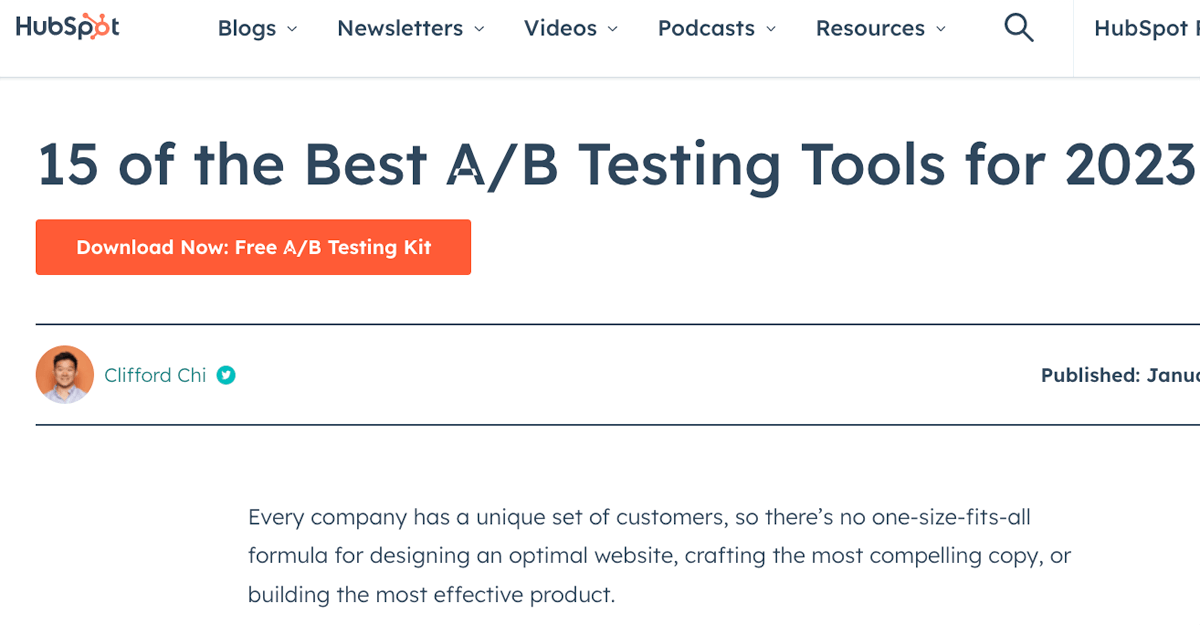
You’re on the internet trying to learn about A/B testing and you come across an article written by HubSpot. You click it and read the article. It’s informative, and you vibe with the writing style. A few weeks later you return to Google and search for the best A/B testing tools. HubSpot pops up again, this time with a listicle of the 15 best options.
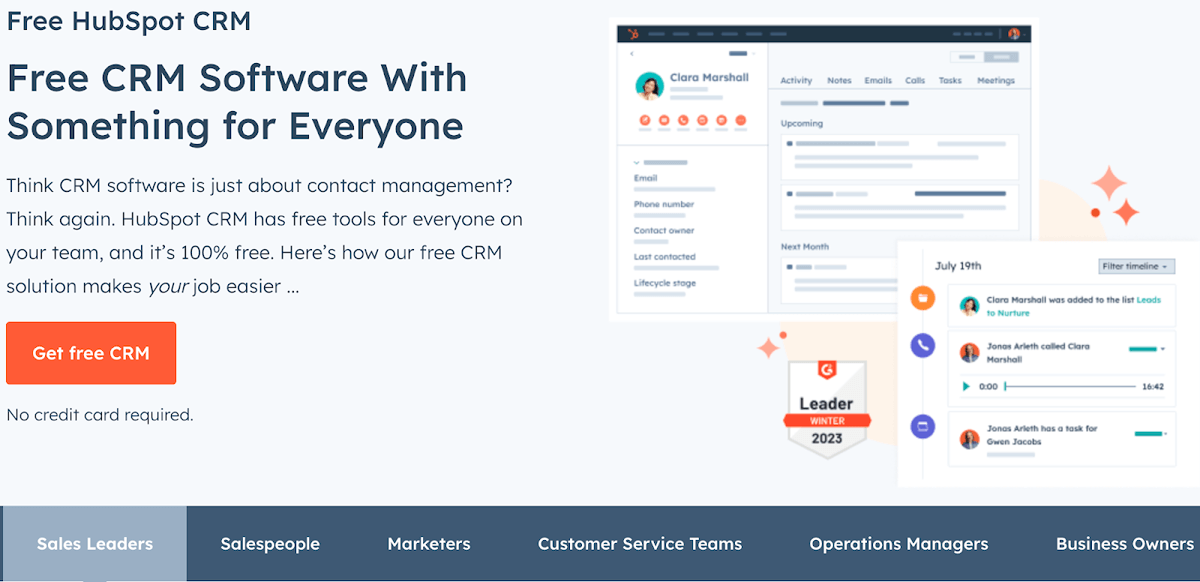
For two weeks you use the A/B testing toolkit and like the results. But you’re hungry for more functionality, especially for your email marketing campaigns. You’re also in need of a full-service CRM to support your expanding business, and from what you’ve read in HubSpot’s content you know HubSpot has a great one. You go to the product page and review the pricing and features.
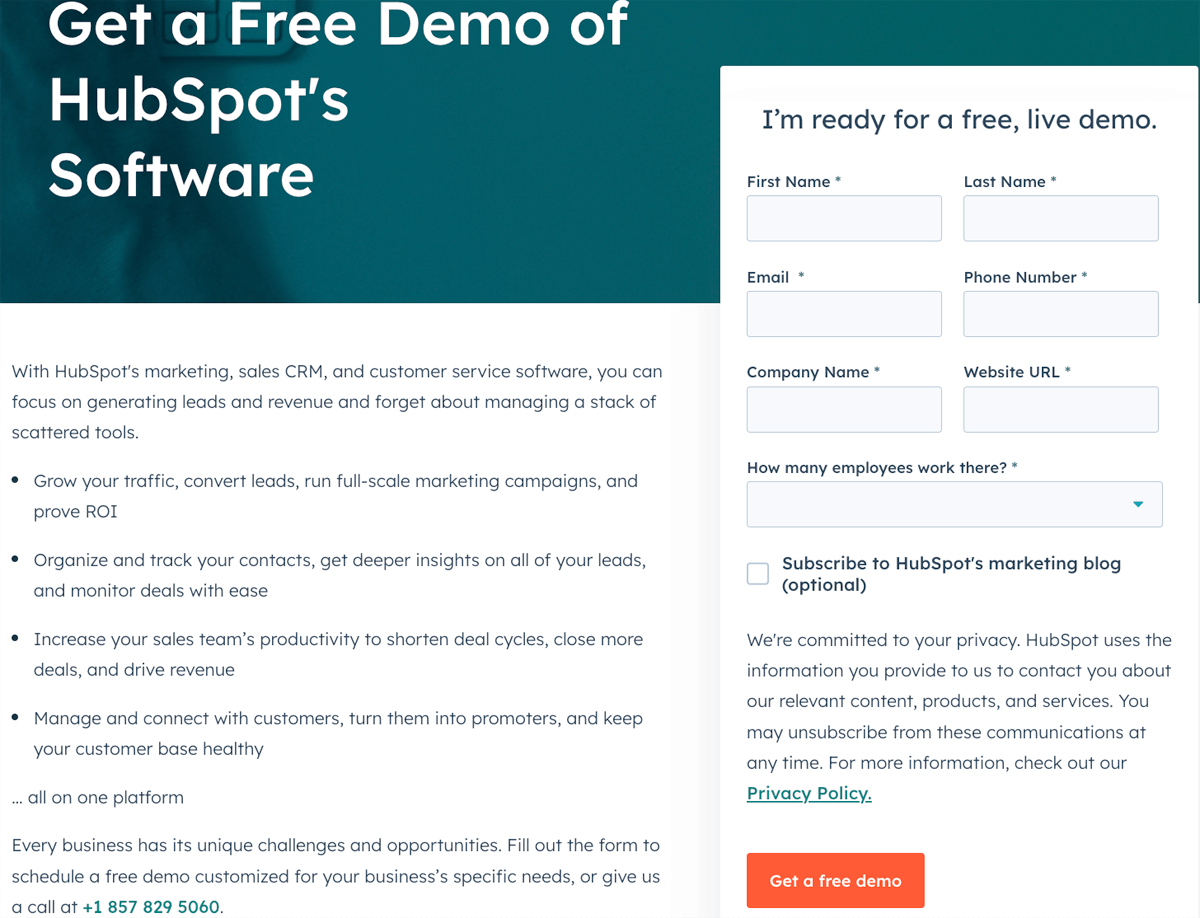
The free CRM is tempting for the price, but you feel that the Starter plan unlocks features you need. You’re still not convinced it’s the right option for you though, so you read a few customer reviews of the product, ask their live chat some questions, and do some more research. You want to know how it looks to use the software, so you book a free demo with a sales rep.
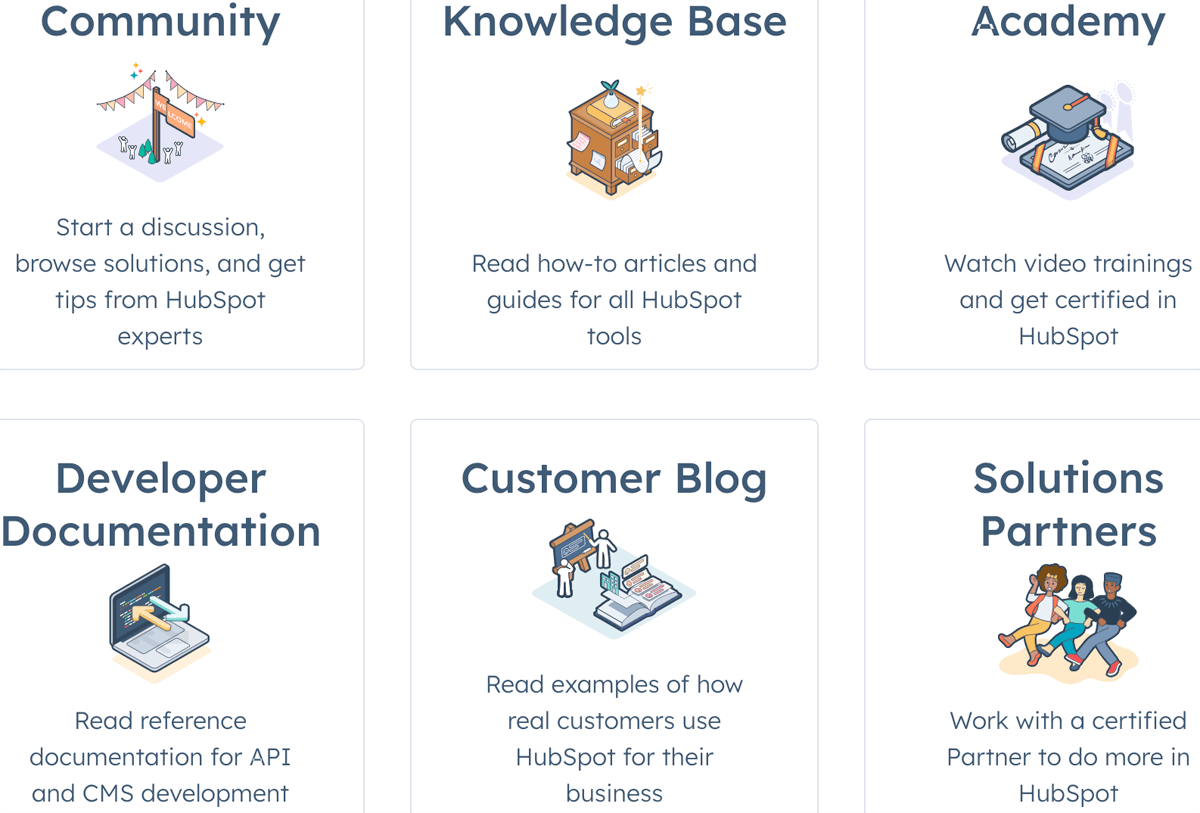
The demo goes well and you decide to make the purchase. The salesperson sends over a contract and you sign it. Next, you experience onboarding and implementation. A customer service rep helps you integrate the software with your other tools and shows you some A/B testing tricks. Over the next several months, you use the software religiously and love it. You also frequently visit HubSpot’s Help Center to get quick answers to your questions.
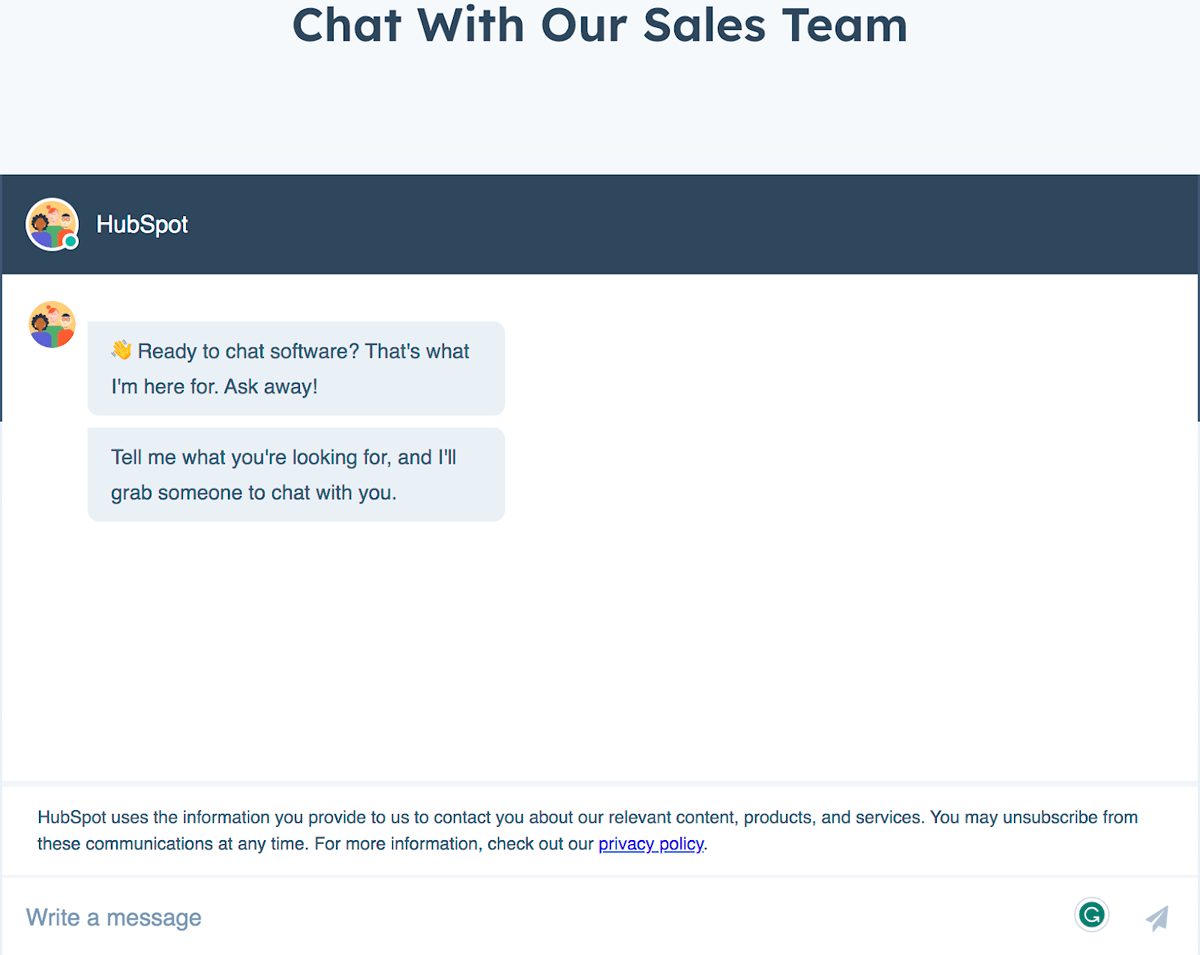
10 months after purchasing the CRM, your contract is up for renewal in two months. You’re confident that you want to continue working with HubSpot, but you think it might be time to upgrade your plan to the Professional Tier, so you contact sales via chat and discuss the benefits and implications of upgrading.
In this example, you end up deciding to stick with the current product due to budgetary concerns, but you have the goal of upgrading next year. For this renewal period, the company uses auto-renew, meaning the contract is automatically extended. You don’t have to do anything unless you want to cancel the subscription. You find this convenient and consider it just another sign to continue working with this brand.
Sales funnel software is an online tool that helps you create, manage, and optimize your business’s sales funnel. Most businesses use a CRM with sales funnel features such as a funnel builder, lead and prospect tracking, and funnel reporting. They should also offer sales and marketing automation, which helps you move buyers through the funnel toward a purchase while saving time. Read on to learn about the three best CRMs for managing your sales funnel.
[fitlink slug="freshsales-crm"]Freshsales[/fitlink] is a sales CRM with a powerful suite of sales funnel features. With a free starting price for three users, it took home first prize in our buyer’s guide for the best sales funnel software. In the platform, you can create web forms, landing pages, and email automations and manage your sales funnel with a drag-and-drop editor. Plus, the funnel metrics help you uncover stale deals, bottlenecks in your sales funnel, and other intel to optimize your funnel.
Choosing the right software ensures that you’re able to effectively manage and optimize your funnel, but it’s not the only best practice you need to follow. Read on to learn some tips that will help you make the most of your sales funnel.
Every business is going to have a different sales funnel, but there are some principle tactics that no one should ignore. These are creating lead magnets to capture lead information, running email nurturing campaigns, leveraging your CRM for time-saving automations, and using A/B testing to optimize the content in your sales funnel. Read on to double-click into each tactic.
A lead magnet is a piece of gated content that users can access only after submitting their contact information through an online form. Examples include e-books, webinars, free trials, and newsletters. When they’re valuable and tailored to the desires of your target audience, they’re great for generating leads for your business who you can then nurture through the funnel using targeted methods. Check out our article to learn how to create lead magnets that convert.
Running automated email campaigns is a powerful lead nurturing strategy. Using email automation software, or a CRM, you can track lead behavior and send them pre-written marketing emails that relate to their current stage in the sales funnel. Most of the emails will share useful educational content, but every now and then you’ll promote your product or service. Read our article to learn how to create email nurturing campaigns.
CRMs typically offer sales and marketing automation functionality. For example, most tools enable you to automate email follow-ups, sales task assignments, email marketing, and sales funnel stage transitions. Some also offer chatbots to take over welcoming leads to your website or product pages. These CRM automations ensure that leads and customers in your sales funnel always get the attention they need, even if your team is busy doing something else.
Most sales funnel software platforms, including CRMs, offer A/B testing tools that allow you to test your marketing content, emails, and web pages against variations. This helps you optimize your funnel. For example, you could compare two versions of a sales page, sending 100 users to each, and tracking which page has the higher conversion rate. To learn more about the software necessary for doing this, check out HubSpot’s guide on the best A/B testing tools.
When you combine a powerful sales funnel with the right software and best practices, you’ll create a rushing river that consistently sweeps up and carries leads downstream towards customer status.
The key difference between a sales funnel and a sales pipeline has to do with the point of view. While a sales pipeline illustrates the steps a salesperson has to go through to make a sale from start to finish, a sales funnel documents the customer journey, and the stages a typical lead goes through to become a customer. The pipeline is also focused on metrics like revenue or total number of deals, while the sales funnel focuses on conversion and dropout rates.
Another notable distinction is that the sales funnel’s first stage is brand awareness. Meanwhile, a sales pipeline begins only when a salesperson gets involved, so you’ll typically see salespeople naming their first pipeline stage “contact made” or “cold email sent.” In general, the sales team focuses on managing the pipeline, and the marketing team focuses on managing the sales funnel, though overlap does occur.
A fine-tuned sales funnel that’s documented in your sales funnel software will enable you to consistently make sales, track the effectiveness of your marketing and sales techniques, and optimize your funnel gradually over time. To see how the sales funnel fits in with other concepts like sales pipeline and sales methodology, read our article on the sales process.


Sam is a former SaaS sales rep turned freelance writer. He spent his career selling real estate technology to C-suite executives before switching over to blogging, where he now covers sales, marketing, and small business topics. Sam specializes in lead generation, lead nurturing, and deal closing articles for Selling Signals. When he’s not researching the latest sales trends, he’s either penning short stories, hiking, or reading in NYC’s Washington Square Park.

Selling Signals delivers actionable advice for sales and marketing professionals. Learn strategies that help you hit targets, strengthen customer relationships, and win more business. Get expert advice on lead generation, sales processes, CRM software, sales management, and account management directly to your inbox.
Property of TechnologyAdvice. © 2025 TechnologyAdvice. All Rights Reserved
Advertiser Disclosure: Some of the products that appear on this site are from companies from which TechnologyAdvice receives compensation. This compensation may impact how and where products appear on this site including, for example, the order in which they appear. TechnologyAdvice does not include all companies or all types of products available in the marketplace.